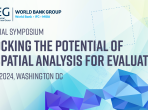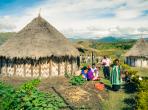Displaying 1 - 10 of 5551

What role should environmental considerations play in evaluation?
Environmental considerations must be implemented across all our evaluation work in a strategically selective way for maximum impact.

Geospatial Symposium—Unlocking the Potential of Geospatial Analysis for Evaluation
In an era characterized by the proliferation of location-based data and the growing accessibility of affordable computing resources, geospatial analysis has become a cornerstone for deciphering the complexities of our…

Future of evaluation: Charting a path in a changing development landscape
A Series of Virtual Events

Reaching women and girls in fragile countries - in nine figures
Lessons from the Independent Evaluation Group’s assessment of World Bank Group support on promoting women’s and girls’ economic empowerment and addressing gender-based violence in FCV countries

Meet Virginia Ziulu, IEG's Data Science Trailblazer
In the medical field, an image can produce the right diagnosis and ultimately save a life. This notion, transferred to surveying the complexities of global development, captivated Virginia Ziulu.
The geospatial…

Celebrating women in evaluation
IEG is celebrating the remarkable contribution of women to the evaluation practice. Listen to some of them as they share perspectives on gender equality, how they continue to push for progress, and their message to…
Learning in World Bank Lending (Approach Paper)
The World Bank has a comparative advantage in development knowledge. External assessments, Independent Evaluation Group (IEG) evaluations, and client surveys done by the World Bank and others consistently show that…

The World Bank Group in Papua New Guinea, 2008-23
This evaluation assesses the relevance and effectiveness of the World Bank Group’s support to Papua New Guinea during Fiscal Years 2008-23.

🎧 Reaching women and girls trapped in violence and conflict
Listen on: Apple Podcast, Spotify, or Google Podcasts
Women and girls living in countries affected by fragility, conflict, and violence face multiple barriers that marginalize them from economic life and put them…

Leveraging Imagery Data in Evaluations
This paper explores the potential of imagery data in evaluations and presents various data types and methodologies demonstrating their advantages and limitations

